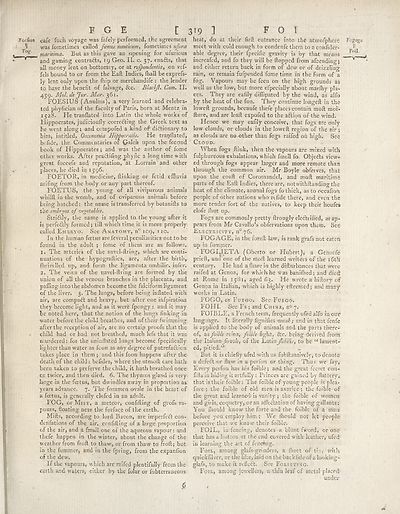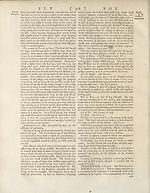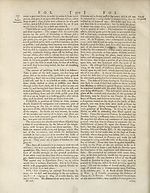Encyclopaedia Britannica > Volume 7, ETM-GOA
(347) Page 319
Download files
Complete book:
Individual page:
Thumbnail gallery: Grid view | List view

FOE [ ,
Foefius cafe fuch voyage was fafely performed, the agreement
'I was fometimes called farms nauticum, fometimes ufura
F')g maritima. But as this gave an opening for ufurious
" ' and gaming contracts, 19 Geo. II. c. 37. ena&s, that
all money lent on bottomry, or at refpondentia, on vef-
fels bound to or from the Eaft Indies, (hall be exprefs-
ly lent only upon the Ihip or merchandife : the lender
to have the benefit of falvage, &c. Blachjl. Com. II.
459. Mol. de Jur. Mar. 361.
FOESIUS (Anulius), a very learned and celebra¬
ted phyfician of the faculty of Paris, born at Mentz in
1528. He tranflated into Latin the whole works of
Hippocrates, judicioufly corredling the Greek text as
he went along; and compofed a kind of dictionary to
him, intitled, Oeconemia Hippocratis. He tranflated,
btfide, the Commentaries of Galeh upon the fecond
book of Hippocrates; and was the author of fome
other works. After praCtifing phyfic a long time with
great fuccefs and reputation, at Lorrain'and other
places, he died in 1596.
FOETOR, in medicine, {linking, or fetid effluvia
arifing from the body or any part thereof.
FOETUS, the young of all viviparous animals
vvhilll in the womb, and of oviparous animals before
being hatched: the name is transferred by botanifts to
the embryos of vegetables.
Stridlly, the name is applied to the young after it
is perfedly formed; till which time it is more properly
called Embryo. See Anatomy, n° 109,'no.
In the human foetus are feveral peculiarities not to be
found in the adult ; fome of them are as follows.
1. The arteries of the navel-firing, which are conti¬
nuations of the hypograftics, are, after the birth,
fhriveiled up, and form the ligamenta umbilic. infer.
2. The veins of the navel-firing are formed by the
union of all the venous branches in the placenta, and
pafiing into the abdomen become the falciform ligament
of the liver. 3. The lungs, before being inflated with
air, are compadl and heavy, but after one infpiratiou
they become light, and as it were fpongy : and it may
be noted here, that the notion of the lungs finking in
water before the child breathes, and of their fwimmrng
after the reception of air, are no certain proofs that the
child had or had not breathed, much lefs that it was
murdered: for the uninftated lungs become fpecifically
lighter than water as fcon as any degree of putrefadlion
takes place in them ; and this foon happens after the
death of the child: befides, where the utmofi care hath
been taken to preferve the child, it hath breathed once
or twice, and then died. 6. The thymus gland is very
large in the foetus, but dwindles away in proportion as
years advance. 7. The foramen ovale in the heart of
a foetus, is generally clofed in an adult.
FOG, or Mist, a meteor, confifting of grofs va¬
pours, floating near the furface of the earth.
Mifts, according to lord Bacon, are imperfeft con-
derifations of the air, confifting of a large proportion
of the air, and a fmall one of the aqueous vapour: and
thefe happen in the winter, about the change of the
weather from frofi to thaw, or from thaw to frofi; but
in the fummer, and in the fpring, from the expanfion
of the dew.
If the vapours, which are raifed plentifully from the
earth and waters, either by the folar or fubterraneous
6
119] F O 1
heat, do at their firfi entrance into the atmofphere
meet with cold enough to condenfe them to a confidcr-
abie degree, their fpecific gravity is by that means
increafed, and fo they will be flopped from afeending;
and either return back in form of dew or of drizzling
rain, or remain fufpended fome time in the form of a
fog. Vapours may be feen on the high grounds as
well as the low, but more efpecially about marftiy pla¬
ces. They are eafily difiipated by the wind, as alfo
by the heat of the fun. They continue longeft in the
loweft grounds, becaufe thefe places contain moft moi-
fture, and are leaft expofed to the a&ion of the wind.
Hence we may eafily conceive, that fogs are only
low clouds, or clouds in the loweft region of the air ;
as clouds are no other than fogs raifed oh high. See
Cloud.
When fogs ftink, then the vapours are mixed with
fulphureous exhalations, which fmell fo. Obje&s view^
ed through fogs appear larger and more remote than
through the common air. Mr Boyle obferves, that
upon the coaft of Coromandel, and moft maritime
parts of the Eaft Indies, there are, notwithftanding the
heat of the climate, annual fogs fo thick, as to occafion,
people of other nations who refide there, and even the
more tender fort of the natives, to keep their houfes
clofe fhut up.
Fogs are commonly pretty ftrongly electrified, as ap¬
pears from Mr Cavallo’s obfervations upon them. See
Electricity, n° 76.
FOG AGE, in the foreft-law, is rank grafs pot eaten
up in fumprer.
FOGIJETA (Oberto or Hubert), a Genoefe
pried, and one of the moft learned writers of the i6th
century. He had a fliare in the difturbances that were
raifed at Genoa, for which-he was baniflred; and died
at Rome in 1581, aged 63. He wrote a hiftory of
Genoa in Italian, which is highly efteemed; and many*
works in Latin.
FOGO, cr Fuego. See Fuego.
FOHI. See Fe; and China, n° 7.
FOIBLE, a French term, frequently ufed alfo in our*
language. It literally fignifies weak; and in that fenfe
is applied to the body of animals and the parts there¬
of, as foible reins, foible fight, &c. being derived from
the ItalianjfeWe, of the LatinJlebilis, to be “ lament¬
ed, pitied.”
But it is chiefly ufed with us fubftantively, to denote
a deleft or flaw in a perfon or thing. Thus we fay.
Every perfon has his foible; and the great fecret foil-,
fifts in hiding it artfully: Princes are gained by flattery,
that istheir foible: The foible of young people is plea-
fure ; the foible of old men is avarice ; the foible of
the great and learned1 is vanity ; the foible of women
and girls, coquetry, or an affeftation of having gallants:
You flioiild know the forte and the foible of a man
before you employ him : We fhould not let people
perceive that we know their foible.
FOIL, in fencing, denotes a blunt fword, or one
that has a button at the end covered with leather, ufed
in learning the art of fencing.
Foil, among glafs-grinders, a (beet of tr:, with
quickfilver, or the like, laid on the backfide of a looking-
glafs, to make it refleft. See Foliating.
Foil, among jewellers, a thin leaf of metal placed
under
Foefius cafe fuch voyage was fafely performed, the agreement
'I was fometimes called farms nauticum, fometimes ufura
F')g maritima. But as this gave an opening for ufurious
" ' and gaming contracts, 19 Geo. II. c. 37. ena&s, that
all money lent on bottomry, or at refpondentia, on vef-
fels bound to or from the Eaft Indies, (hall be exprefs-
ly lent only upon the Ihip or merchandife : the lender
to have the benefit of falvage, &c. Blachjl. Com. II.
459. Mol. de Jur. Mar. 361.
FOESIUS (Anulius), a very learned and celebra¬
ted phyfician of the faculty of Paris, born at Mentz in
1528. He tranflated into Latin the whole works of
Hippocrates, judicioufly corredling the Greek text as
he went along; and compofed a kind of dictionary to
him, intitled, Oeconemia Hippocratis. He tranflated,
btfide, the Commentaries of Galeh upon the fecond
book of Hippocrates; and was the author of fome
other works. After praCtifing phyfic a long time with
great fuccefs and reputation, at Lorrain'and other
places, he died in 1596.
FOETOR, in medicine, {linking, or fetid effluvia
arifing from the body or any part thereof.
FOETUS, the young of all viviparous animals
vvhilll in the womb, and of oviparous animals before
being hatched: the name is transferred by botanifts to
the embryos of vegetables.
Stridlly, the name is applied to the young after it
is perfedly formed; till which time it is more properly
called Embryo. See Anatomy, n° 109,'no.
In the human foetus are feveral peculiarities not to be
found in the adult ; fome of them are as follows.
1. The arteries of the navel-firing, which are conti¬
nuations of the hypograftics, are, after the birth,
fhriveiled up, and form the ligamenta umbilic. infer.
2. The veins of the navel-firing are formed by the
union of all the venous branches in the placenta, and
pafiing into the abdomen become the falciform ligament
of the liver. 3. The lungs, before being inflated with
air, are compadl and heavy, but after one infpiratiou
they become light, and as it were fpongy : and it may
be noted here, that the notion of the lungs finking in
water before the child breathes, and of their fwimmrng
after the reception of air, are no certain proofs that the
child had or had not breathed, much lefs that it was
murdered: for the uninftated lungs become fpecifically
lighter than water as fcon as any degree of putrefadlion
takes place in them ; and this foon happens after the
death of the child: befides, where the utmofi care hath
been taken to preferve the child, it hath breathed once
or twice, and then died. 6. The thymus gland is very
large in the foetus, but dwindles away in proportion as
years advance. 7. The foramen ovale in the heart of
a foetus, is generally clofed in an adult.
FOG, or Mist, a meteor, confifting of grofs va¬
pours, floating near the furface of the earth.
Mifts, according to lord Bacon, are imperfeft con-
derifations of the air, confifting of a large proportion
of the air, and a fmall one of the aqueous vapour: and
thefe happen in the winter, about the change of the
weather from frofi to thaw, or from thaw to frofi; but
in the fummer, and in the fpring, from the expanfion
of the dew.
If the vapours, which are raifed plentifully from the
earth and waters, either by the folar or fubterraneous
6
119] F O 1
heat, do at their firfi entrance into the atmofphere
meet with cold enough to condenfe them to a confidcr-
abie degree, their fpecific gravity is by that means
increafed, and fo they will be flopped from afeending;
and either return back in form of dew or of drizzling
rain, or remain fufpended fome time in the form of a
fog. Vapours may be feen on the high grounds as
well as the low, but more efpecially about marftiy pla¬
ces. They are eafily difiipated by the wind, as alfo
by the heat of the fun. They continue longeft in the
loweft grounds, becaufe thefe places contain moft moi-
fture, and are leaft expofed to the a&ion of the wind.
Hence we may eafily conceive, that fogs are only
low clouds, or clouds in the loweft region of the air ;
as clouds are no other than fogs raifed oh high. See
Cloud.
When fogs ftink, then the vapours are mixed with
fulphureous exhalations, which fmell fo. Obje&s view^
ed through fogs appear larger and more remote than
through the common air. Mr Boyle obferves, that
upon the coaft of Coromandel, and moft maritime
parts of the Eaft Indies, there are, notwithftanding the
heat of the climate, annual fogs fo thick, as to occafion,
people of other nations who refide there, and even the
more tender fort of the natives, to keep their houfes
clofe fhut up.
Fogs are commonly pretty ftrongly electrified, as ap¬
pears from Mr Cavallo’s obfervations upon them. See
Electricity, n° 76.
FOG AGE, in the foreft-law, is rank grafs pot eaten
up in fumprer.
FOGIJETA (Oberto or Hubert), a Genoefe
pried, and one of the moft learned writers of the i6th
century. He had a fliare in the difturbances that were
raifed at Genoa, for which-he was baniflred; and died
at Rome in 1581, aged 63. He wrote a hiftory of
Genoa in Italian, which is highly efteemed; and many*
works in Latin.
FOGO, cr Fuego. See Fuego.
FOHI. See Fe; and China, n° 7.
FOIBLE, a French term, frequently ufed alfo in our*
language. It literally fignifies weak; and in that fenfe
is applied to the body of animals and the parts there¬
of, as foible reins, foible fight, &c. being derived from
the ItalianjfeWe, of the LatinJlebilis, to be “ lament¬
ed, pitied.”
But it is chiefly ufed with us fubftantively, to denote
a deleft or flaw in a perfon or thing. Thus we fay.
Every perfon has his foible; and the great fecret foil-,
fifts in hiding it artfully: Princes are gained by flattery,
that istheir foible: The foible of young people is plea-
fure ; the foible of old men is avarice ; the foible of
the great and learned1 is vanity ; the foible of women
and girls, coquetry, or an affeftation of having gallants:
You flioiild know the forte and the foible of a man
before you employ him : We fhould not let people
perceive that we know their foible.
FOIL, in fencing, denotes a blunt fword, or one
that has a button at the end covered with leather, ufed
in learning the art of fencing.
Foil, among glafs-grinders, a (beet of tr:, with
quickfilver, or the like, laid on the backfide of a looking-
glafs, to make it refleft. See Foliating.
Foil, among jewellers, a thin leaf of metal placed
under
Set display mode to:
![]() Universal Viewer |
Universal Viewer | ![]() Mirador |
Large image | Transcription
Mirador |
Large image | Transcription
Images and transcriptions on this page, including medium image downloads, may be used under the Creative Commons Attribution 4.0 International Licence unless otherwise stated. ![]()
| Encyclopaedia Britannica > Encyclopaedia Britannica > Volume 7, ETM-GOA > (347) Page 319 |
|---|
| Permanent URL | https://digital.nls.uk/189125740 |
|---|
| Attribution and copyright: |
|
|---|
| Description | Ten editions of 'Encyclopaedia Britannica', issued from 1768-1903, in 231 volumes. Originally issued in 100 weekly parts (3 volumes) between 1768 and 1771 by publishers: Colin Macfarquhar and Andrew Bell (Edinburgh); editor: William Smellie: engraver: Andrew Bell. Expanded editions in the 19th century featured more volumes and contributions from leading experts in their fields. Managed and published in Edinburgh up to the 9th edition (25 volumes, from 1875-1889); the 10th edition (1902-1903) re-issued the 9th edition, with 11 supplementary volumes. |
|---|---|
| Additional NLS resources: |
|

